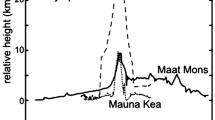Abstract
In Quaternary carbonate units composed mostly of eolianites, paleosols are important stratigraphic markers that help differentiate episodes of carbonate deposition tied to glacio-eustatic sea level fluctuations. Paleosols used in this manner can be misinterpreted, and thus lead to errors in interpretation of the geologic record. Some possible pitfalls include: failure to differentiate between terra-rossa paleosols and calcarenite protosols; failure to recognize that separate paleosols may merge laterally into composite paleosols; failure to recognize that single paleosols may bifurcate in highly weathered bedrock; and failure to recognize soil-derived material that infills karst features. The Quaternary carbonates of the Bahamas are used to illustrate these pitfalls, which may occur in carbonates of any age.
Similar content being viewed by others
References
BIRKELAND, P. W., 1984,Soils and Geomorphology, Oxford University Press, London, 372 p.
BRETZ, J. H., 1960, Bermuda: a partially drowned, late mature Pleistocene karst: Bulletin Geol. Soc. Amer., v. 71, p. 1729–1754.
CAREW, J. L., and MYLROIE, J. E., 1985, Pleistocene and Holocene stratigraphy of San Salvador Island, Bahamas, with reference to marine and terrestrial lithofacies at French Bay,in Curran, H. A., ed., Guidebook for Geological Society of America, Orlando, Annual Meeting Field Trip #2, Fort Lauderdale, FL, CCFL Bahamian Field Station, p. 11–61.
CAREW, J. L., and MYLROIE, J. E., 1987, A refined geochronology for San Salvador Island, Bahamas,in Curran, H. A., ed.,Proceedings of the Third Symposium on the Geology of the Bahamas, Fort Lauderdale, FL, CCFL Bahamian Field Station, p. 35–44.
GARRETT, P., and GOULD, S. J., 1984, Geology of New Providence Island, Bahamas:Geol. Soc. Amer. Bulletin, v. 95, p. 209–220.
HARMON, R. S., MITTERER, R. M., KRIAUSAKUL, N., LAND, L. S., SCHWARCZ, H. P., GARRETT, P., LARSON, G. J., VACHER, H. L., and ROWE, M., 1983, U-series and amino-acid racemization geochronology of Bermuda: Implications for eustatic sealevel fluctuation over the past 250,000 years:Paleogeogr.Paleoclim. Paleoecol., v. 44, p. 41–70.
LAND, L. S., MACKENZIE, F. T., and GOULD, S. J., 1967, The Pleistocene history of Bermuda:Geol. Soc. Amer. Bulletin, v. 78, p. 993–1006.
MUHS, D. R. and BUSH, C. A., 1987, Uraniumseries age determinations of Quaternary eolianites and implications for sea-level history, New Providence Islands, Bahamas: Geol. Soc. Amer. abstracts with programs, v. 19, no. 7, p. 780.
MUHS, D. R., CRITTENDEN, R. C., ROSHOLT, J. N., BUSH, C. A. and STEWART, K. C., 1987, Genesis of marine terrace soils, Barbados, West Indies: evidence from mineralogy and geochemistry:Earth Surface Processes and Land forms, v. 12, p. 605–618.
MYLROIE, J. E., and CAREW, J. L., 1988, Solution conduits as indicators of Late Quaternary sea level position:Quat. Sci. Reviews, v. 7, p. 55–64.
MYLROIE, J. E., and CAREW, J. L., 1990, The flank margin model for dissolution cave development in carbonate platforms:Earth Surface Processes and Landforms, v. 15, p. 413–424.
RUHE, R. V., 1965, Quaternary Paleopedology,in Wright, H. E. and Frey, D. G., eds.,The Quaternary of the United States, INQUA Rev. Vol., Princeton Univ. Press, p. 755–764.
RUHE, R. V., CADY, J. G., and GOMEZ, R. Z., 1961, Paleosols of Bermuda:Geolo. Soc. America Bull. v. 72, p. 1121–1142.
SAYLES, R. W., 1931, Bermuda during the Ice Age:American Academy of Arts and Sciences, v. 66, p. 381–468.
THOMAS, D. S. G., 1988, The biogeomorphology of arid and semi-arid environments,in Viles, H. A., ed.,Biogeomorphology, Basil Blackwell, NY, p. 193–221.
VACHER, H. L. and HARMON, R. S., 1987,1987 Penrose Conference fieldguide to the geology of Bermuda, 48 p.
VACHER, H. L. and HEARTY, P., 1989, History of Stage 5 sea level in Bermuda: review with new evidence of a brief rise to present sea level during substage 5A:Quaternary Science Reviews, v. 8, p. 159–168.
Author information
Authors and Affiliations
Rights and permissions
About this article
Cite this article
Carew, J.L., Mylroie, J.E. Some pitfalls in paleosol interpretation in carbonate sequences. Carbonates Evaporites 6, 69–74 (1991). https://doi.org/10.1007/BF03175383
Received:
Accepted:
Published:
Issue Date:
DOI: https://doi.org/10.1007/BF03175383




